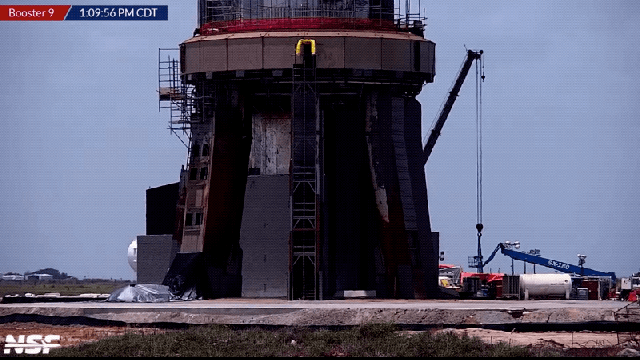Earlier today, SpaceX performed the second test of its newly installed Starship deluge system. This test was considerably more powerful than the first one, which the company conducted on July 17.
The demo took place at SpaceX’s Starbase facility in Boca Chica, Texas, with the test commencing at 2:10 p.m. ET. Water shot upwards from beneath the orbital launch mount (OLM) for roughly 40 seconds, and it was accompanied by a voluminous blast of sound. No booster was present for this test. NASASpaceflight captured the dramatic—and very wet—moment (to quickly view the test, jog the dial to 1:10 p.m. CT, as seen in the top left of the video).
Although the test was anticipated to be a full-pressure demonstration, official confirmation is still pending. The Elon Musk-led company has yet to disclose the exact volume of water it propelled through the system, though SpaceX claims it would like to discharge as much as 350,000 gallons of water during launches of Starship.
The system appeared to do what it was supposed to do: spray copious amounts of water in an upward direction. When implemented in actual launch scenarios, the deluge system will function in tandem with engine ignition, absorbing the power generated by Starship’s 33 Raptor engines. A plausible next step will be for SpaceX to test the deluge system during a static fire test of the Starship Super Heavy booster.
A functioning water deluge system will work in SpaceX’s favor to protect the pad during launches of Starship and to convince the Federal Aviation Administration that the company is worthy of another Starship launch license. To that end, SpaceX has also constructed a metal diverter beneath the OLM. This infrastructure (both the water deluge system and the giant metal plate) was absent during the inaugural launch of Starship on April 20, resulting in substantial damage to the OLM and the expulsion of dust and debris into the surrounding areas. In the aftermath of that launch, the FAA is now facing a lawsuit for authorizing it, while Starship remains grounded pending an investigation.
During its maiden flight, Starship lasted for approximately four minutes before entering into a fatal tumble that forced controllers to issue a self-destruct command. SpaceX is now working towards the second launch, saying it’s in the process of implementing thousands of tweaks to the 394-foot Starship—the most powerful rocket ever built.
For more spaceflight in your life, follow us on Twitter and bookmark Gizmodo’s dedicated Spaceflight page.
